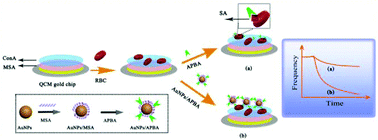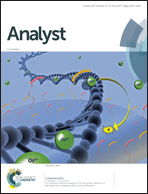Erythrocytes-based quartz crystal microbalance cytosensor for in situ detection of cell surface sialic acid†
Abstract
An erythrocytes (RBCs) cytosensor was first fabricated for in situ analysis of sialic acid (SA) on the cell surface based on a quartz crystal microbalance (QCM). RBCs, as a recognition element, were immobilized on a concanavalin A (ConA)-modified gold chip through the specific recognition between ConA and mannose on the cell surface. 4-Aminobenzeneboronic acid (APBA)-functionalized gold nanoparticles (AuNPs/APBA) were used as a signal amplification nanoprobe for labeling SA on the surface of RBCs. Compared to that of APBA, the frequency response of the cytosensor could be significantly enhanced 18-fold by using a AuNPs/APBA nanoprobe. RBCs can be detected in the range of 2.6 × 103 to 7.2 × 106 cells per mL with a detection limit of 1.1 × 103 cells per mL. The proposed cytosensor was further applied to detect the expression level of SA on normal and diabetic RBCs in situ, which showed that the average number of SA expressed on single normal and diabetic RBC surfaces were 2.1 ± 0.2 × 108 and 8.2 ± 0.7 × 107 with a relative standard deviation of 4.3% and 3.6%, respectively. The strategy shows an in situ and high sensitivity method for the quantitative evaluation of SA expression on RBC surface and provides a new alternative methodology to analyze glycan expression at the cell surface.



 Please wait while we load your content...
Please wait while we load your content...